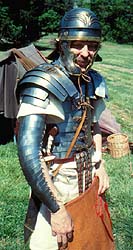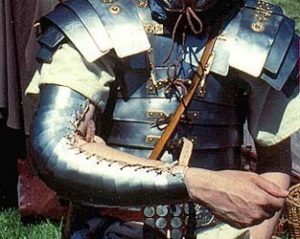| Author |
Message |
Gerald Fa.

|
 Posted: Sun 05 Oct, 2014 9:17 pm Post subject: What are the different articulations in armor (manly plate) Posted: Sun 05 Oct, 2014 9:17 pm Post subject: What are the different articulations in armor (manly plate) |
 |
|
Ok I do not understand the terms of "shell articulation", "floating articulation" and then there is "compression articulation" on armor. Can someone help me a bit! Because I feel really dumb right now, as I thought I knew a lot about armor, and yet there is always something that will fly at me like "what is that?"
Also I herd that the Italians generally use "shell articulation" while Germans use "floating articulation". Is that overall true? (well not for every signal armor but generally)
What other articulations are there? Can anyone give me examples or pictures?
THANKS!! 
|
|
  |
 |
|
Mart Shearer
|
 Posted: Sun 05 Oct, 2014 11:25 pm Post subject: Posted: Sun 05 Oct, 2014 11:25 pm Post subject: |
 |
|
"Shell articulation" on the front of the knee, and "compression articulation" over the back of the joint.

"Floating articulation" is held together with straps or lacing points rather than rivets.

At least that's my meager understanding of the way the terminology is generally used.
ferrum ferro acuitur et homo exacuit faciem amici sui
|
|
  |
 |
|
Lafayette C Curtis
|
 Posted: Mon 06 Oct, 2014 5:34 am Post subject: Posted: Mon 06 Oct, 2014 5:34 am Post subject: |
 |
|
|
I don't think you'll get any sort of satisfactory answer from forum posts, since these terms carry a great deal of technical baggage with them with regards to how individual pieces/lames in the articulation would have to be shaped, assembled, and articulated with other pieces. If you're really curious, why not get a relatively accessible armouring book like Brian Price's Techniques of Medieval Armor Reproduction?
|
|
  |
 |
Gerald Fa.

|
 Posted: Mon 06 Oct, 2014 10:46 am Post subject: Posted: Mon 06 Oct, 2014 10:46 am Post subject: |
 |
|
| Mart Shearer wrote: | "Shell articulation" on the front of the knee, and "compression articulation" over the back of the joint.

"Floating articulation" is held together with straps or lacing points rather than rivets.

At least that's my meager understanding of the way the terminology is generally used. |
Hummmmm, I see, looks entrusting. Is one better than the other? Or are there ups &downs to one and the other?
| Lafayette C Curtis wrote: | | I don't think you'll get any sort of satisfactory answer from forum posts, since these terms carry a great deal of technical baggage with them with regards to how individual pieces/lames in the articulation would have to be shaped, assembled, and articulated with other pieces. If you're really curious, why not get a relatively accessible armouring book like Brian Price's Techniques of Medieval Armor Reproduction? |
I see what you are saying. And yes I do agree with you 100%, but for now I want to get any general idea of what they are.
This may sound bad but the thing is I have been so busy these past few weeks that I do not have the patience on looking it up even on the Arms & armor books I have. I have a hard time looking up in Google, so I came here to see of I can get any general idea at the very least on a quick answer. HOWEVER when I have time I will start my readings again even if it is answered on here; as it is always good to have books to back one person up. Things should calm down no later thanby the 19th of this month or a bit sooner. 
|
|
  |
 |
|
Mark Griffin
Location: The Welsh Marches, in the hills above Newtown, Powys. Joined: 28 Dec 2006
Posts: 802
|
 Posted: Mon 06 Oct, 2014 12:28 pm Post subject: Posted: Mon 06 Oct, 2014 12:28 pm Post subject: |
 |
|
I'm thinking...why do you need to know?
| Quote: | | ummmmm, I see, looks entrusting. Is one better than the other? Or are there ups &downs to one and the other? |
They are used mainly because thats the best method for the job in hand or there just isn't any other way to create the item and make it work. A negative point that springs to mind is that floating items can wear through whatever they are suspended by but thats solved by having a second one in place or just using jolly good points and tieing them so excess movement and abrasion is minimised.
There are only a few items that can float realy, couters and pauldrons and the main ones.
'shell' articulation is not something I've heard in general use. you only get compression articulation on lames that have slots in the rivet holes so the lames not only swivel on the shank of the rivet but can slide over each other. Not sure what I'd call lames that simply have a hole that allows the lames to rotate on that axis and not move laterally....
Currently working on projects ranging from Elizabethan pageants to a WW1 Tank, Victorian fairgrounds 1066 events and more. Oh and we joust loads!.. We run over 250 events for English Heritage each year plus many others for Historic Royal Palaces, Historic Scotland, the National Trust and more. If you live in the UK and are interested in working for us just drop us a line with a cv.
|
|
  |
 |
Gerald Fa.

|
 Posted: Tue 21 Oct, 2014 12:40 pm Post subject: Posted: Tue 21 Oct, 2014 12:40 pm Post subject: |
 |
|
| Mark Griffin wrote: | I'm thinking...why do you need to know?
| Quote: | | ummmmm, I see, looks entrusting. Is one better than the other? Or are there ups &downs to one and the other? |
They are used mainly because thats the best method for the job in hand or there just isn't any other way to create the item and make it work. A negative point that springs to mind is that floating items can wear through whatever they are suspended by but thats solved by having a second one in place or just using jolly good points and tieing them so excess movement and abrasion is minimised.
There are only a few items that can float realy, couters and pauldrons and the main ones.
'shell' articulation is not something I've heard in general use. you only get compression articulation on lames that have slots in the rivet holes so the lames not only swivel on the shank of the rivet but can slide over each other. Not sure what I'd call lames that simply have a hole that allows the lames to rotate on that axis and not move laterally.... |
I see now, but one last thing.
 And or And or 
Would the Lorica Segmentata Roman armor and that arm armor you see there be "compression articulation"?
|
|
  |
 |
|
Jeffrey Faulk
|
 Posted: Tue 21 Oct, 2014 2:02 pm Post subject: Posted: Tue 21 Oct, 2014 2:02 pm Post subject: |
 |
|
| Quote: | | Would the Lorica Segmentata Roman armor and that arm armor you see there be "compression articulation"? |
I am unsure of what you could call it specifically, but I believe it would fall under a category of 'floating' articulation. The body of the lorica was held together by leather strips riveted to the plates, and the shoulders were held in much the same manner, attached to the body by hooks. The arm armour is laced together. It flexes, it does not actually 'compress' as in the pieces collapsing into each other. They are 'floating' because they are not riveted together by metal-to-metal joints but rather by metal to leather, and they are not fixed one plate to another.
To put it another way-- regular articulation covers the *outside* of a bend, while compression articulation has to be made in such a way that it covers the *inside* of the bend. It is a very different dynamic than regular articulation although it shares the same basic principles of plates attached to and interacting with each other.
That's my understanding of it anyway...
|
|
  |
 |
|
|

